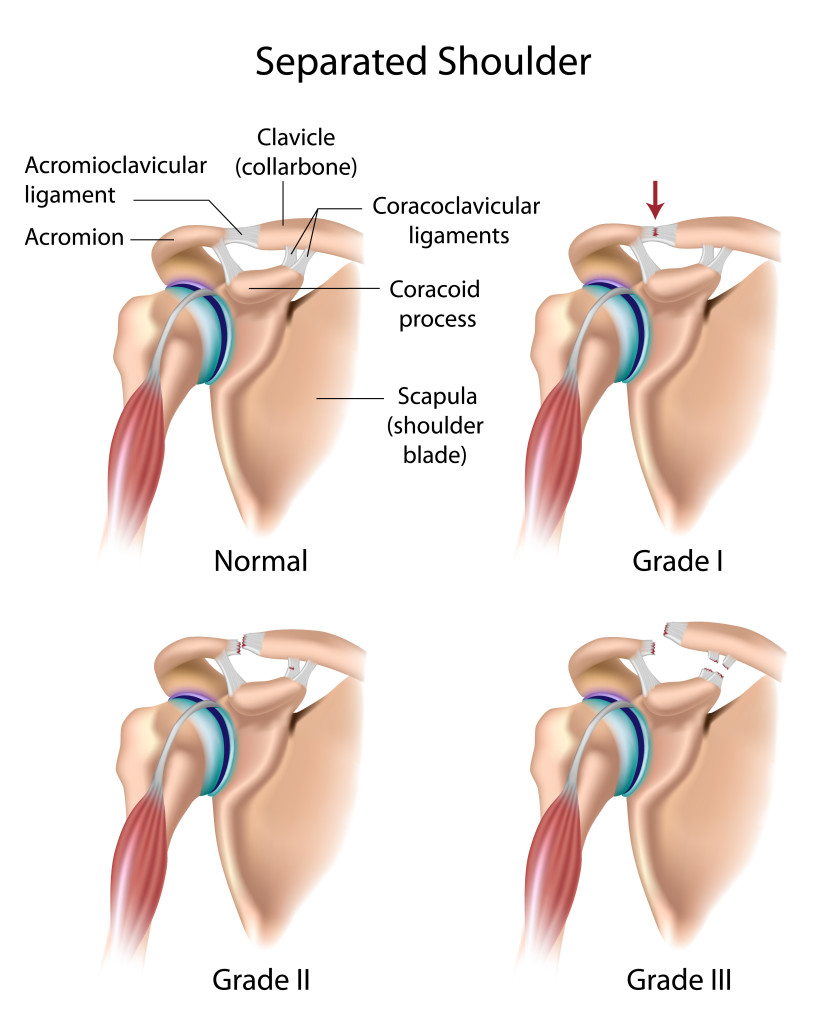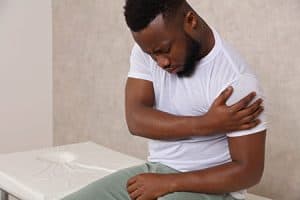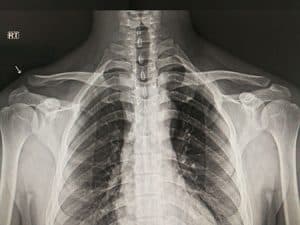Shoulder separation treatment in Burr Ridge
Also serving Plainfield, Morris and surrounding areas
| Procedure | • Arthroscopic, Outpatient • Torn ligaments are repaired and the Clavicle and Shoulder blade are re-connected with either sutures or metal screw |
| Duration | 1.5 hours |
| Anesthesia | General |
| Recovery | • Sling for 4–6 weeks • Physical Therapy for 2–3 months • Return to work depends on type of work • Return to full sports generally 4–5 months. |
More about Shoulder Separation/ AC Joint Injury

At the top of the shoulder there is a connecting joint between the outer end of the Collar Bone and the upper portion of the Shoulder Blade. This small joint is called the Acromio-clavicular (AC) joint and is often injured in contact sports such as football or with a direct blow of any kind to this area. This is commonly referred to as a shoulder separation. This is different than a shoulder dislocation in which the ball and socket become separated.
Injury may range from a sprain or bruise, to an actual separation of the Collar Bone from the Shoulder Blade. The majority of these injuries are treated without surgery. If the bones are severely separated, then surgical repair may be required to reposition the bones.
There are 6 Grades of AC Joint injury with Grades I-III typically treated without surgery. Grades IV through VI generally require surgery to repair the torn ligaments and reposition the Clavicle and the Shoulder Blade back to their normal anatomical position. Earlier treatment gives the best prognosis for stable repair of the AC joint after injury. Cases that are chronic (greater than 2-3 months old) have less ability for natural healing and require more extensive reconstructive procedures which are less successful in stabilizing the joint.

Frequently Asked Questions about Shoulder Separation/AC Joint Injuries
What is the difference between a shoulder separation and a shoulder dislocation?
A shoulder separation refers to an injury of the acromioclavicular (AC) joint that connects the end of the collarbone and the upper shoulder blade. A shoulder dislocation occurs when the top of the arm bone and the socket of the shoulder blade lose contact with each other.
How does the AC joint get injured?
The AC joint can be injured by a direct blow to the shoulder or by falling onto the shoulder or onto an outstretched arm.
Sometimes the AC joint can become injured due to repeated use over time that puts too much stress on the joint. Repeated heavy lifting or other tasks that require the arms to stretch overhead can wear down the cartilage of the joint and lead to an injury.
What are the symptoms of a shoulder separation?
Shoulder separation/AC joint injuries can cause the following symptoms:
- Pain and swelling in the shoulder
- Tenderness around the top of the shoulder
- A noticeable lump or deformity on the top of the shoulder
- Loss of shoulder motion or strength
- An audible popping noise when moving the shoulder joint
How do doctors diagnose an AC joint injury?
When diagnosing a shoulder separation, Dr. Burt take down a complete patient history, noting the onset, nature and frequency of symptoms. The doctor inquires whether the patient is unable to perform any activities because of shoulder pain or symptoms. They will also look for any external factors that could cause or contribute to the pain.
Dr. Burt performs a physical examination of the shoulder and take X-rays of the shoulder to determine the severity of the injury.
What are non-surgical treatments for shoulder separation?
Non-surgical treatments for shoulder separation include resting the shoulder (i.e., putting the arm in a sling to minimize movement) and icing the shoulder. Anti-inflammatory medications can help alleviate pain.
Physical therapy is also crucial for improving shoulder movement, strength and range of motion and reducing shoulder pain when performing daily movements and activities. Functional training can help patients retrain their shoulder movements and positions during more demanding activities without putting too much strain on the AC joint.
How is shoulder separation treated surgically?
For more severe shoulder separations, Dr. Burt can perform shoulder surgery to reposition the collarbone and shoulder blade normally and repair injured ligaments of the joint.
What does the recovery from shoulder surgery entail?
Recovery details vary depending on the type of surgery performed. In general, most patients must immobilize the shoulder and use a sling for approximately four weeks after surgery. There are restrictions on shoulder motion, heavy lifting and overhead movements while the shoulder initially heals. Dr. Burt provides a specific recovery timeline based on the patient, the nature of his or her injury and the specific treatment plan.
A physical therapy program is typically recommended after surgery to restore normal movement, strength and range of motion to the shoulder.
Can I have shoulder separation surgery if I have diabetes?

Diabetes and other medical conditions do not rule out shoulder separation surgery but do require more consideration for the procedure’s timing and recovery. Comorbid conditions, such as diabetes and hypertension, can impact shoulder surgery. Diabetes may lead to longer hospital stays following shoulder surgery, and diabetes, hypertension, and obesity can increase post-operative complications, such as:
- Infection in the surgical site
- Slow wound healing
- Problems with fluids, electrolytes, the kidneys, and the heart
If you have diabetes and require shoulder separation surgery, you should focus on proper glycemic control in the weeks before your procedure. Your blood sugar should be within the target range on the day of (and preferably one week prior to) your procedure. Patients with diabetes experience better outcomes and heal faster if their blood sugar is controlled during surgery. Some surgeons may delay surgery if blood sugar is too high when the patient arrives at the hospital on the day of their procedure.
People taking insulin may require an early morning shoulder surgery to lower the risk of blood sugar problems related to fasting, and these patients may need to monitor their blood sugar more often during recovery. Discuss your medical condition(s) with Dr. Burt during your appointment at Midwest Sports Medicine Institute and provide a list of medications and their dosages to avoid unnecessary risks.
What causes shoulder separation?
Shoulder separation often happens after a direct fall on the shoulder or a sudden blow to the top area of the shoulder. These injuries tear the tissue connecting the collarbone and shoulder blade and are typically linked to a sports injury or car accident. High-impact sports may cause an athlete to fall to the ground with force, and another player may even land on them, worsening the impact. The shoulder bears the brunt of these falls and separates. A slip and fall injury, falling off a bike, or an accident while ice skating or rollerblading may cause shoulder separation.
Older adults may experience shoulder separation from seemingly minor incidents, such as picking up a heavy object or a twisting shoulder motion. The shoulder ligaments weaken with age and are more easily damaged.
What will happen if shoulder separation is not treated?

Untreated shoulder separation may require more extensive treatment and lead to complications. You may end up with loss of range of motion, persistent pain, and weaker muscles. The joint continues to weaken over time and may require total shoulder replacement instead of shoulder separation surgery. Treating shoulder separation as soon as possible is best to prevent further complications and avoid lengthy treatment and higher medical expenses. Treating shoulder separation can restore your quality of life, address pain, and improve your range of motion.
How can I prevent shoulder separation?
While there are no steps you can take to stop a first-time shoulder injury, you can avoid a secondary issue by following your rehabilitation plan to the T and ensuring the shoulder heals completely before returning to your sport or the activity that led to the initial injury.
Schedule an Appointment Today
Orthopaedic surgeons Dr. David Burt has many years of experience treating patients who suffer from shoulder injuries, including shoulder dislocation and shoulder separation. During an appointment, the doctors will evaluate the extent of injury and make recommendations for treatment. If you have suffered a shoulder separation, schedule an appointment at Midwest Sports Medicine Institute in Burr Ridge by calling (630) 455-2000, in Plainfield by calling (815) 267-8825, or in Morris by calling (815) 941-1885. Dr. Burt is proud to provide advanced care to patients from Naperville, Joliet, Aurora, and throughout the Chicago area.
Recent posts
Lateral Decubitus Position for Arthroscopic Suprapectoral Biceps Tenodesis

The purpose of this report is to describe arthroscopic suprapectoral biceps tenodesis in the lateral decubitus position. Many technique descriptions for this procedure emphasize the beach-chair position to obtain optimal anterior subdeltoid visualization of the relevant anatomy. This is not...
Read MorePhysician's corner: Dr. David Burt

Two years ago, Dr. David Burt opened up his third clinic with Midwest Sports Medicine Institute in Burr Ridge. Along with locations in Plainfield and Morris, Dr. Burt is able to treat countless of athletes of all ages and levels...
Read More
